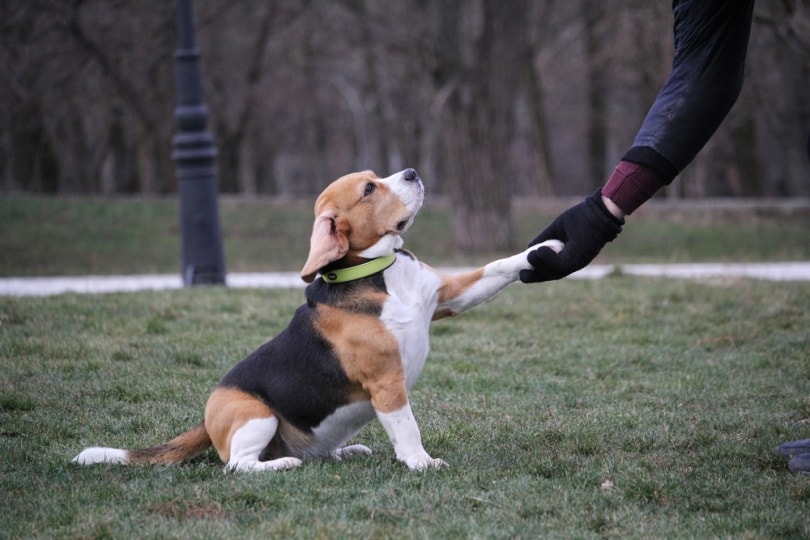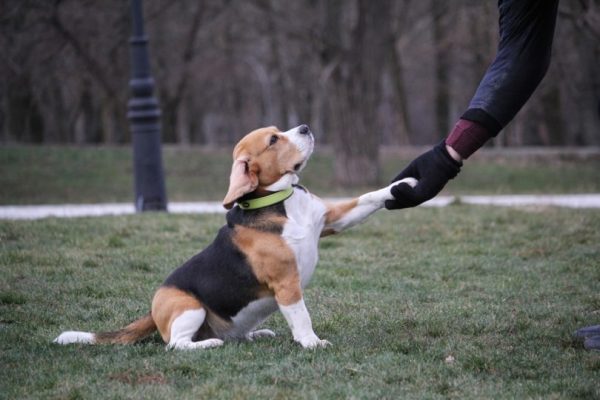Beagles are a bit harder to train than other dog breeds. In the past, they were bred to independently track rabbits and other animals without needing to follow the commands of the hunter. While this is great for the hunter, it also means that Beagles still aren’t very good at listening to commands. They can be a bit stubborn, to say the least.
Therefore, it typically takes a bit more work to train these dogs than other breeds. However, with a bit of work, you can easily train your Beagle just like any other dog.
How Hard Are Beagles to Train?
Beagles are typically considered one of the harder breeds to train. As scent dogs, they have a very powerful nose and were bred to follow it at all costs. Generally, this means that they are distractible when it comes to training, especially when smells are involved. Their nose will win every day of the week.
Because they were bred for hunting, these dogs rely on instinct more than anything else. Therefore, they can appear a bit stubborn, though this isn’t necessarily on purpose. Instead, these dogs simply weren’t bred to override their instincts on commands—quite the opposite.
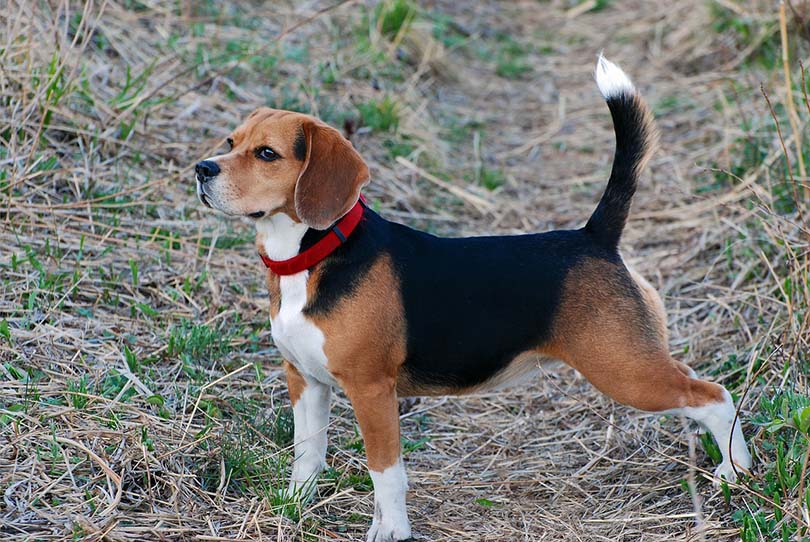
These dogs also have moderately high energy levels. Therefore, they can get a bit excited and energetic during training, which can make training sessions a challenge. For this reason, we recommend exercising these dogs before you train them. It will help them concentrate and prevent distractions.
However, these dogs are also very food-driven so they will respond well to treats, which can help them overcome some of their distractibility. For this reason, we do recommend having treats on hand and using positive reinforcement training.
How to Train a Beagle
You train a Beagle just like you train any other dog. However, some extra tips may make training your Beagle a little more doable. Here are some of the things we recommend keeping in mind when training your dog.
1. Follow a Schedule
Beagles do best when there is a consistent schedule, especially when they are house training. These dogs are smaller, active, and stubborn. All of these things make it harder to house-train them. You’ll need to take them outside every few hours during the early stages of the process. A schedule helps you and your puppy stay on track.
Be sure to incorporate regular training sessions, as well. A short, 10-minute session is better than a longer session one day a week. Remember, these dogs are very distractible, so long training sessions just don’t work.
2. Start Early
You should begin training your puppy as soon as you bring them home. These dogs take a bit longer to train than your average dog. Therefore, it is vital to start early. Plus, the sooner you start your scheduled training, the better your dog will adapt to the training. Get in a routine as soon as your dog is old enough.
Once your puppy has completed their vaccination schedule, you can take them to puppy classes, as well. Beagles are typically very friendly, so they need to worry less about socialization. However, like all dogs, it is still best to introduce them to a wide range of people, dogs, and experiences early so that they aren’t fearful later on.
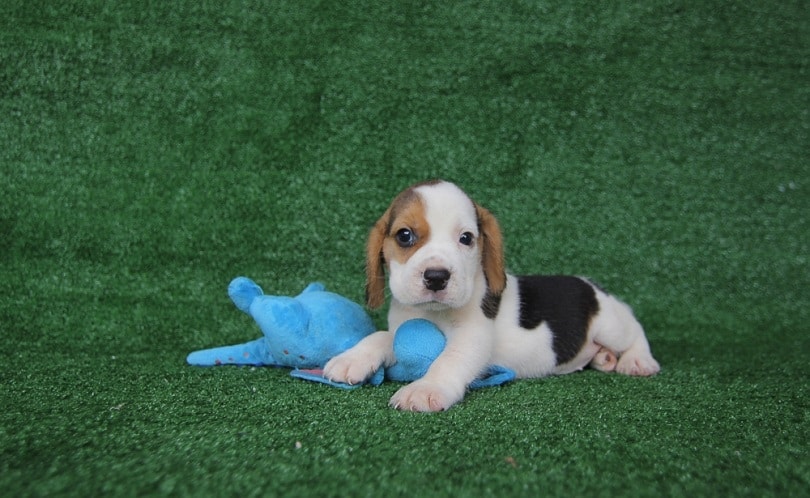
3. Consider Crate Training
Crate training isn’t cruel, as some misconceptions may lead you to believe. Instead, crate training is a bit like creating a safe, calm-down space for your dog. In the beginning, your main goal is to encourage your dog to like their crate. This is done through special toys and treats that are provided while the dog is in the crate. Never use the crate as a punishment, as you want your dog to feel comfortable and happy in the crate.
Crate training helps a lot with house training. Your dog will not want to use the bathroom inside their crate, as this is where they sleep. Therefore, crate training can help you prevent accidents inside, which encourages house training.
4. Use Positive Reinforcement Training
A lot of different training methods have been invented and tried over the years. However, positive reinforcement training is the only method with substantial scientific evidence behind it. Therefore, we recommend positive reinforcement training particularly. Because Beagles are extremely food-driven, this works well.
Beagles can be quite sensitive. Therefore, it is best to avoid punishment, which most dogs don’t understand, anyway.

5. Don’t Forget to Exercise
We all know that dogs need exercise. However, it is easy to forget that exercise and training go hand-in-hand. An unexercised dog will be more reactive, destructive, and distractable. Therefore, without exercise, your Beagle is less likely to behave well and listen during training sessions. A tired dog is often a good dog.
Be sure you incorporate regular exercise into your routine. Always exercise your dog before you have a training session. Having an overly active dog will only lead to frustration for both parties.
6. Reward “Good Enough”
When you’re training your Beagle, be sure to reward any movement in the right direction. For instance, when you’re teaching your dog to “stay,” start by rewarding them for only a few seconds. After that, you can slowly extend the amount of time you ask them to stay before getting the reward. Dogs (and Beagles especially) need very small steps when training.
If you expect your dog to sit for even 15 seconds right off the bat, you’re going to be disappointed. Small steps are key to an effective dog training session.
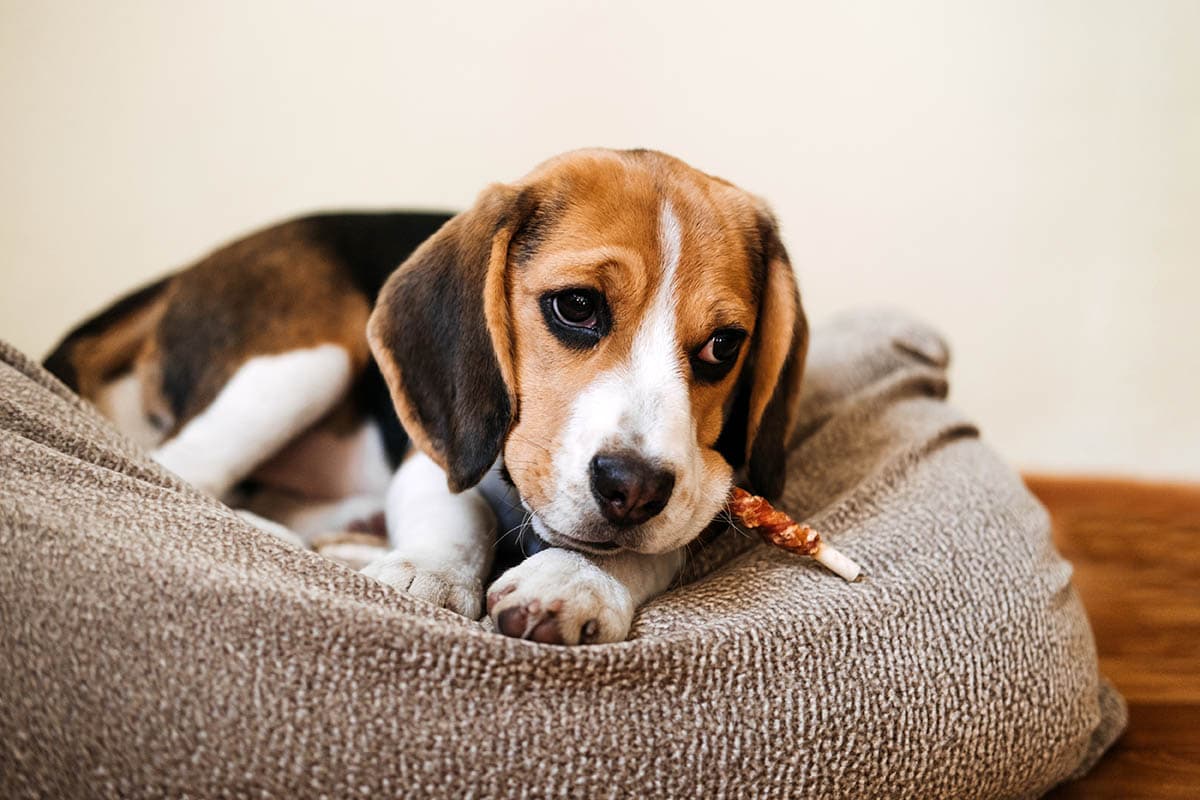
7. Socialization
Getting your dog socialized is just as important as training them. Socialization ensures that your dog is used to a variety of people, animals, and places. Without early introduction, these things may scare your dog when they come across them later on, making them more reactive.
Therefore, we highly recommend that you take your puppy to as many different places as possible when they are young, introducing them to as many people and animals as possible. Puppy training classes work well in this regard. They provide a safe place for your dog to meet new animals and people, not to mention the hustle-and-bustle of a store.
However, classes alone usually aren’t enough to meet all your dog’s training needs. For that, you’ll also have to visit other places that they may come across when they get older.
Conclusion
Beagles may be harder to train than other dogs out there. However, that doesn’t mean that it is impossible to train them. Instead, these dogs just have a harder time overriding their instincts to follow commands, so most training takes a bit longer than average. They can also be very distractible, especially when their nose is involved.
However, with the right methods, you can train your Beagle to “sit,” “stay,” and “down.” You may even get some of their barking under control.
Still, these dogs will never be trained to the level that a well-trained German Shepherd is. It simply isn’t in their blood. They don’t do well when let off-leash, as they will follow their nose wherever they pick up a scent. However, with proper expectations and a lot of patience, your Beagle can still be a well-trained dog.
- Related Read: What Were Beagles Bred For? History of the Beagle
Featured Image Credit: Madeeva_11, Shutterstock

